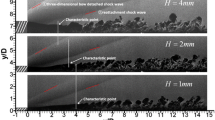Abstract
The interaction of a swept shock wave and a supersonic wake has been studied. The swept shock wave is generated by a swept compression sidewall, and the supersonic wake is generated by a wake generator. The flow field is visualized with the nanoparticle-based planar laser scattering method, and a supplementary numerical simulation is conducted by solving the Reynolds-averaged Navier–Stokes equations. The results show that the pressure rise induced by the swept shock wave can propagate upstream in the wake, which makes the location where vortices are generated move upstream, thickens the laminar section of the wake, and enlarges the generated vortices. The wake is swept away from the swept compression sidewall by the pressure gradient of the swept shock wave. This pressure gradient is not aligned with the density gradient of the supersonic wake, so the baroclinic torque generates streamwise vorticity and changes the distribution of the spanwise vorticity. The wake shock is curved, so the flow downstream of it is non-uniform, leaving the swept shock wave being distorted. A three-dimensional Mach disk structure is generated when the wake shock interacts with the swept shock wave.














Similar content being viewed by others
References
Gaitonde, D.V.: Progress in shock wave/boundary layer interactions. Prog. Aerosp. Sci. 72, 80–99 (2015)
Verma, S.B., Hadjadj, A.: Supersonic flow control. Shock Waves 25, 443–449 (2015)
Menon, S.: Shock-wave-induced mixing enhancement in scramjet combustors. AIAA Paper 89-0104 (1989)
Liu, J.J., Sheng, Y., Sislian, J.P.: Shock waves and turbulence in a hypersonic inlet. Shock Waves 4, 237–245 (1995)
Battam, N.W., Gorounov, D.G., Korolev, G.L., Ruban, A.I.: Shock wave interaction with a viscous wake in supersonic flow. J. Fluid Mech. 504, 301–341 (2004)
Walsh, M.J.: Turbulent wake/shock interaction at Mach 6. AIAA Paper 78-225 (1978)
Zhang, Y.L., Wang, B., Zhang, H.Q., Xue, S.Y.: Mixing enhancement of compressible planar mixing layer impinged by oblique shock waves. J. Propuls. Power 31(1), 156–169 (2015)
Li, Z.R., Jaberi, F.A.: Numerical investigations of shock-turbulence interactions in a planar mixing layer. AIAA Paper 2010-112 (2010)
Marble, F.E., Hendricks, G.J., Zukoski, E.E.: Progress Toward Shock Enhancement of Supersonic Combustion Processes. In: Borghi, R., Murthy, S.N.B. (eds.) Turbulent Reactive Flows. Lecture Notes in Engineering, vol. 40. Springer, New York, NY (1989)
Clemens, N.T., Mungal, M.G.: Effects of sidewall disturbances on the supersonic mixing layer. J. Propuls. Power 8(1), 249–251 (1992)
Zhao, Y.X., Yi, S.H., Tian, L.F., Cheng, Z.Y.: Supersonic flow imaging via nanoparticles. Sci. China E Technol. Sci. 52(12), 3640–3648 (2009)
Feng, J.H., Shen, C.B., Wang, Q.C.: Three-dimensional evolution of large-scale vortices in supersonic flow. Appl. Phys. Lett. 107, 254101 (2015)
He, L., Yi, S.H., Chen, Z., Zhu, Y.: Visualization of the structure of an incident shock wave/turbulent boundary layer interaction. Shock Waves 24, 583–592 (2014)
Zhao, Y.X., Yi, S.H., Tian, L.F., Chen, Z.Y.: The fractal measurement of experimental images of supersonic turbulent mixing layer. Sci. China G Phys. Mech. Astron. 51(8), 1134–1143 (2008)
Zhao, Y.X., Yi, S.H., Tian, L.F., He, L., Chen, Z.Y.: Density field measurement and approximate reconstruction of supersonic mixing layer. Chin. Sci. Bull. 55(19), 2004–2009 (2010)
Clemens, N.T., Smith, M.F., Fernandez, J.V.: Observations of supersonic flat plate wake transition. AIAA Paper 96-0785 (1996)
Clemens, N.T., Smith, M.F.: Observations of supersonic flat plate wake transition. AIAA J. 36(7), 1328–1330 (1998)
Harris, P.J., Fasel, H.F.: Numerical investigation of the unsteady behavior of supersonic plane wakes. AIAA Paper 98-2974 (1998)
Golik, R.J., Webb, W.H., Lees, L.: Further results of viscous interaction theory for the laminar supersonic near wake. AIAA Paper 67-61 (1967)
Panaras, A.G.: Review of the physics of swept-shock/boundary layer interactions. Prog. Aerosp. Sci. 32, 173–244 (1996)
Gutmark, E.J., Schadow, K.C., Yu, K.H.: Mixing enhancement in supersonic free shear flows. Annu. Rev. Fluid Mech. 27, 375–417 (1995)
Cooke, J.C., Hall, M.G.: Boundary layers in three dimensions. Prog. Aerosp. Sci. 2(2), 221–282 (1962)
Acknowledgements
This work has been supported by the National Nature Science Foundation of China (Grant No. 11472304).
Author information
Authors and Affiliations
Corresponding author
Additional information
Communicated by K. Hannemann.
Rights and permissions
About this article
Cite this article
He, G., Zhao, Y.X. & Zhou, J. Interaction of a swept shock wave and a supersonic wake. Shock Waves 27, 761–770 (2017). https://doi.org/10.1007/s00193-017-0719-7
Received:
Revised:
Accepted:
Published:
Issue Date:
DOI: https://doi.org/10.1007/s00193-017-0719-7




